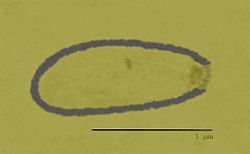| ピソウイルス
|
 ピソウイルス
|
| 分類
|
|
|
| 学名
|
| Pithovirus
|
| 種
|
|
Pithovirus sibericum
|
ピソウイルス (Pithovirus) はウイルスの属の一つ。アメーバに感染する Pithovirus sibericum 1種のみを含む[1][2]。二本鎖DNAを持ち、巨大核質DNAウイルスに含まれる。2014年にシベリアの永久凍土から採取された、3万年前の氷床コアから発見された。
形態
属名 Pithovirus は、古代ギリシャの甕であるピトスに形が似ることから命名された。長径1.5µm、短径0.5µmで、これまでに知られていた最大のウイルス、パンドラウイルスの2倍の大きさである[3]。一端が開いた楕円球型の細胞壁を持ち、内部はハニカム構造となっている[1]。
ゲノムには約500の遺伝子が含まれる。これは典型的なウイルスより多いが、パンドラウイルスと比べると1桁ほど小さい[3]。つまり、本種のゲノムは他のウイルスと比べ、遺伝子密度が低いということである。また、2/3のタンパク質は、他のウイルスでは見られないものであった。ゲノム配列はパンドラウイルスよりも、マルセイユウイルス科・メガウイルス科・イリドウイルス科などのウイルスと類似している[4]。これらの科は全て正二十面体の大型DNAウイルスである。パンドラウイルスのゲノムのGC含量が61%を超えるのに対し、ピソウイルスでは36%で、この値はメガウイルス科のものに近い[5]。
複製
天然痘ウイルスなどのDNAウイルスと同じように、複製は宿主の細胞質で行われる[4]。
発見
エクス=マルセイユ大学のジャン・ミシェル・クラブリーとシャンタル・アベルジェルが率いる研究チームにより、シベリア、チュクチ自治管区沿岸の永久凍土から採取された、3万年前の氷床コアから発見された[1]。これは、後期更新世の堆積物の30m下から採取されたものである[2][4]。2000年に採取された川岸のサンプルからアメーバが現れ[6]、死にかけたアメーバを調べたところ、巨大なウイルスが発見された。発見者は、氷床コアを調べるというアイデアは、2012年に、氷床コアからスガワラビランジの蘇生に成功した、という話から思いついたと語っている[1]。本種の発見は、2014年3月、米国科学アカデミー紀要で発表された[3][5]。
脚注
- ^ a b c d Yong, Ed (3 March 2014). “Giant virus resurrected from 30,000-year-old ice : Nature News & Comment”. Nature. doi:10.1038/nature.2014.14801.
- ^ a b Morelle, Rebecca (3 March 2014). “30,000-year-old giant virus 'comes back to life'”. BBC News. http://www.bbc.com/news/science-environment-26387276
- ^ a b c Sirucek, Stefan (3 March 2014). “Ancient "Giant Virus" Revived From Siberian Permafrost”. National Geographic. http://news.nationalgeographic.com/news/2014/03/140303-giant-virus-permafrost-siberia-pithovirus-pandoravirus-science/
- ^ a b c Racaniello, Vincent (4 March 2014). “Pithovirus: Bigger than Pandoravirus with a smaller genome”. Virology Blog. http://www.virology.ws/2014/03/04/pithovirus-bigger-than-pandoravirus-with-a-smaller-genome/
- ^ a b Legendre, Matthieu and Bartoli, Julia and Shmakova, Lyubov and Jeudy, Sandra and Labadie, Karine and Adrait, Annie and Lescot, Magali and Poirot, Olivier and Bertaux, Lionel and Bruley, Christophe and others (2014). “Thirty-thousand-year-old distant relative of giant icosahedral DNA viruses with a pandoravirus morphology”. Proceedings of the National Academy of Sciences. doi:10.1073/pnas.1320670111.
- ^ Zimmer, Carl (3 March 2014). “Out of Siberian Ice, a Virus Revived”. The New York Times. http://www.nytimes.com/2014/03/04/science/out-of-siberian-ice-a-virus-revived.html
